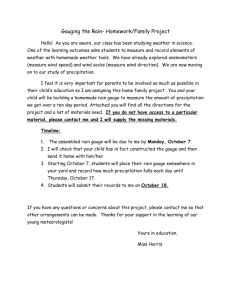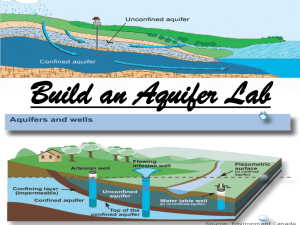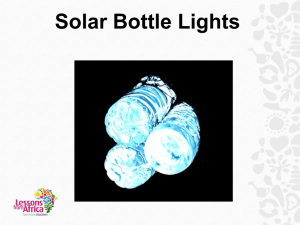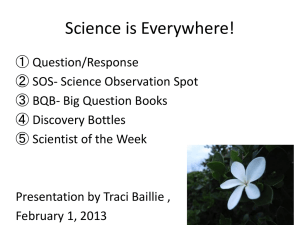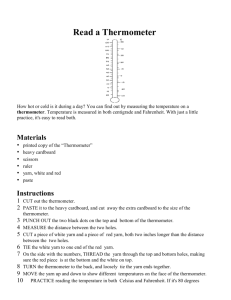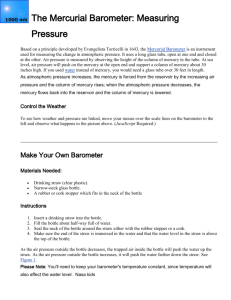Measuring Rainfall
advertisement
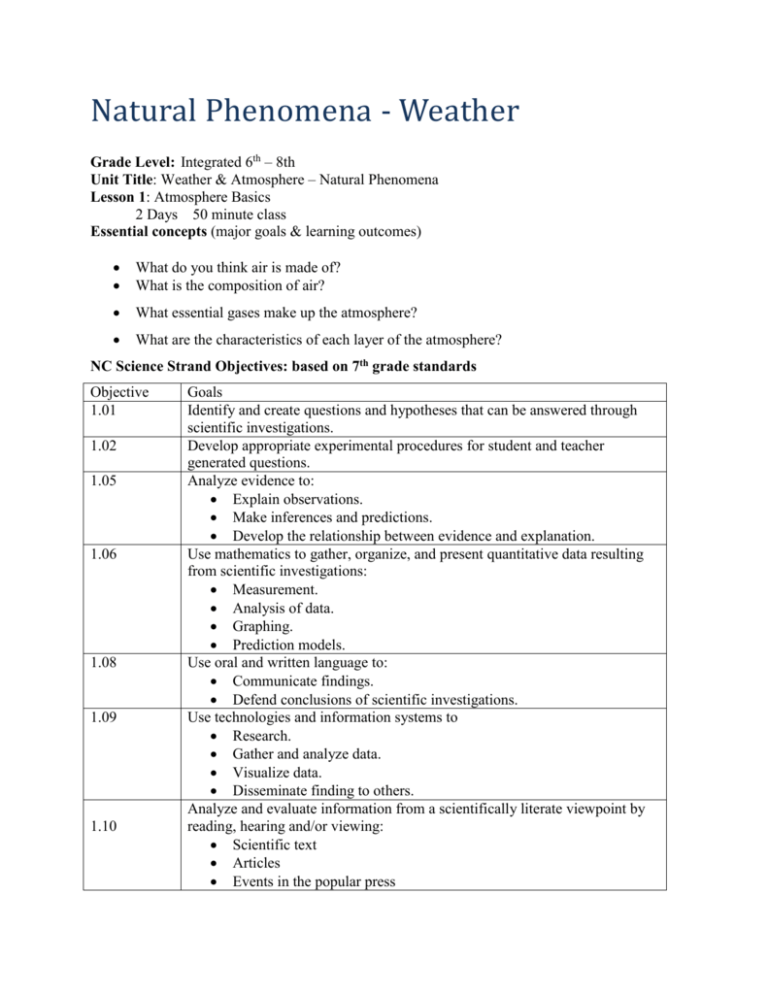
Natural Phenomena - Weather Grade Level: Integrated 6th – 8th Unit Title: Weather & Atmosphere – Natural Phenomena Lesson 1: Atmosphere Basics 2 Days 50 minute class Essential concepts (major goals & learning outcomes) What do you think air is made of? What is the composition of air? What essential gases make up the atmosphere? What are the characteristics of each layer of the atmosphere? NC Science Strand Objectives: based on 7th grade standards Objective 1.01 1.02 1.05 1.06 1.08 1.09 1.10 Goals Identify and create questions and hypotheses that can be answered through scientific investigations. Develop appropriate experimental procedures for student and teacher generated questions. Analyze evidence to: Explain observations. Make inferences and predictions. Develop the relationship between evidence and explanation. Use mathematics to gather, organize, and present quantitative data resulting from scientific investigations: Measurement. Analysis of data. Graphing. Prediction models. Use oral and written language to: Communicate findings. Defend conclusions of scientific investigations. Use technologies and information systems to Research. Gather and analyze data. Visualize data. Disseminate finding to others. Analyze and evaluate information from a scientifically literate viewpoint by reading, hearing and/or viewing: Scientific text Articles Events in the popular press Materials needed: LCD projector Internet access Student computers/laptops Science journals Weather Station (Classroom activity/optional) Temperature Dewpoint Sensor Rain Gauge Cloud Height Sensor Precipitation Identification Sensor Visibility & Day/Night Sensor Wind Sensor Traditional Weather Equipment Photo Procedure: Ask students- What is air? Students are given time to brainstorm their answers to: What is air”. PowerPoint Presentation (open hyperlink to view)Natural Phenomena powerpoint.pptx Student activity: o Students log onto http://urbanext.illinois.edu/treehouse/ and explore the site Assessment: Student’s choice to: (Rubrics for each option, due 2 weeks from starting unit) Make a weather video Write a report on information found on the http://urbanext.illinois.edu/treehouse/seasons.cfm?Slide=1 web site Create a ‘weather log’ “Grab the Dogs” activity Make a Weather Proverb Students choice Activity Details” Students’ choice activities: 1. Make a Weather Video Have groups of students develop a weather report. Assign each group a recent date, and have them research what the weather was that day (temperature, precipitation, clouds, etc.). Have each group make a weather map depicting the weather for that date, and have each person be a weathercaster, with each one discussing a different weather element. 2. Grab the Dogs After looking through the section on storm hazards and safety, have students write what steps they would take if they knew a storm was approaching. If you wish, assign what type of storm hazard they should focus on – thunderstorms, flooding, hurricanes, lightning, etc. You can also have them be in an indoor or outdoor location. 3. Create a ‘weather log’ On a screen picture of the treehouse club, provide a place for inputting temperature, air pressure, wind direction and speed, overall weather, and precipitation – then be able to print out daily or weekly changes as a graph. 4. Make a Weather Proverb There are many sayings that are used to help predict the weather. Some of these include: When dew is on the grass, Rain will not come to pass. A morning fog that hides the sun’s ray means the coming of a clear day. Mackerel sky, Twelve hours dry (A mackerel sky means high level cumulus clouds are present.) A wind from the west means weather’s fair. A wind from the east, foul weather’s near. Red sky at night, sailors delight Red sky at morning, sailor’s take warning. Lesson Extension: Have the class try to come up with some of their own proverbs. They can be about everyday weather, storms, or other weather phenomena. Here are some things that may help students come up with some ideas. Air moves from high pressure to low pressure. A bright reflection from clouds north of the sun may mean colder weather is coming, while a bright cloud reflection south of the sun may mean warmer weather is approaching. If air pressure is rising, fair weather should be coming. If lightning can be heard, people should seek safety. Warm, humid air in early spring or late fall may indicate storms will form. Geography and Weather Integration: Divide the students into groups, and assign each group a geographic location. Using the internet or other sources, have them research what the weather is currently. Use either the site from the Weather Channel (http://www.weather.com/common/welcomepage/world.html), or from the National Weather Service (http://weather.noaa.gov/weather/AF_cc.html). Each group can then report their findings to the rest of the class. Other Teacher Activities for AIG or Special Needs Modifications: Ask students to give the weather report to the class or create a weather report video. Invite a local TV or radio weather person or a person from the weather service. Note the various weather safety weeks and make a bulletin board for the school. Research important historical weather events. What, when, where, who and how? How did it affect people? Look into weather satellites. How do they help with weather forecasting? Who owns them? How long do they last? Research weather instruments of the past. What was used 100 years ago compared to today? Set up a weather station at the school barometer, rain gauge, wind gauge, and thermometer. Another approach would be the gather local weather information off the web and have your own Treehouse Weather Club. The Treehouse Weather Club could give a weather report with school announcements each day. Have someone visit the class who has lived through a weather disaster such as a tornado, flood or hurricane. Make a collection of weather sayings and proverbs. o For starters – “Red sky at night, sailor’s delight. Red sky in the morning, sailors take warning.” o Clear moon, frost soon. o A year of snow, a year of plenty. How does the weather affect our daily lives? ______________________________________________________________________________ Lesson 2: Day 3: Weather Forecasting Essential Concepts: How is weather predicted? What instruments are used in weather predictions? N.C. Objectives met: 1.03, 1.04, 1.05, 1.08, 1.10 Materials Needed: Various library weather books Internet access Newspaper weather articles Laptops/computer access Weather station Student journals TV / Weather channel LCD projector Procedure: Teacher will give lecture on weather prediction information, weather instruments, and meteorology/meteorologists. Powerpoint (open hyperlink to view)Weather Forecasting powerpoint.pptx Taped weather forecasts Weather channel viewing Students will get into collaborative groups of 4 and choose what type of weather instrument they would like to research then create. Choices and materials vary depending on the instrument chosen. (Directions for each attached) ____________________________________________________________________________ Make an Anemometer You will need: five paper cups two straight plastic straws a pin scissors a hole punch a small stapler a sharp pencil with an eraser Procedure Take four of the paper cups. Using the hole punch, punch one hole in each, about 1.5 cm below the rim. Take the fifth cup. Punch four equally spaced holes about 1cm below the rim. Then punch a hole in the centre of the bottom of the cup. Take one of the four cups and push a straw through the hole. Fold the end of the straw, and staple it to the side of the cup across from the hole. Repeat this procedure for another one-hole cup and the second straw. Now slide one cup and straw assembly through two opposite holes in the cup with four holes. Push another one-hole cup onto the end of the straw just pushed through the four-hole cup. Bend the straw and staple it to the one-hole cup, making certain that the cup faces in the opposite direction from the first cup. Repeat this procedure using the other cup and straw assembly and the remaining one-hole cup. Align the four cups so that their open ends face in the same direction (clockwise or anticlockwise) around the centre cup. Push the straight pin through the two straws where they intersect. Push the eraser end of the pencil through the bottom hole in the centre cup. Push the pin into the end of the pencil eraser as far as it will go. Your anemometer is ready to use. Your anemometer is useful because it rotates at the same speed as the wind. This instrument is quite helpful in accurately determining wind speeds because it gives a direct measure of the speed of the wind. To find the wind speed, determine the number of revolutions per minute. Next calculate the circumference of the circle (in metres) made by the rotating paper cups. Multiply the revolutions per minute by the circumference of the circle (in metres per revolution), and you will have the velocity of the wind in metres per minute. The anemometer is an example of a vertical-axis wind collector. It need not be pointed into the wind to spin. ______________________________________________________________________________ Make a Barometer We can measure changes in air pressure by making a barometer using a few simple pieces of equipment. You will need: a jam jar or straight-sided glass a long-necked bottle water mixed with food colouring a marker pen Place the bottle upside down in the jar so that it is resting on the rim. The top of the bottle should be just above the bottom of the jar. Remove the bottle and pour some colored water into the jar. You should use enough so that the water just covers the neck of the bottle when it is in place. On the side of the jar, use the marker pen to mark the current level of the water in the bottle. Put your barometer in a place where the temperature is fairly constant. Mark any changes in the water level over the next few weeks on the side of the jar. Measuring Rainfall Rainfall is usually measured by first collecting it in a rain gauge. These special drums are then used to record the depth of the water inside. Rain gauges are usually about 50 cm tall and are placed on the ground just high enough to avoid splashes. Rain water that is caught in a funnel on top, runs down into a measuring cylinder below – where it can be recorded. To make your own rain gauge to keep a record of how much rain falls, follow the instructions below. You will need: a large plastic soft drinks bottle scissors a ruler a waterproof marker pen (or coloured sticky tape) a heavy flower pot a notepad and pencil (to record the results) With the help of an adult, carefully cut the top off the plastic bottle with the scissors. Turn the top upside down and wedge it in the bottle to form a funnel. (If necessary, use sticky tape to hold the top of the bottle in place). Using a ruler, measure out a scale (in millimeters) on a piece of paper. Either stick this to the side of the bottle, or use the marker pen to mark out the lines instead. Alternatively, cut the colored tape into strips and stick them a certain distance apart (eg: 10 mm) up the side of the bottle. Make sure that whatever you use, it is waterproof! To prevent the rain gauge from blowing over, place it outside in a heavy flowerpot. Alternatively, you could dig a hole in the ground for it to stand in. Make sure the rain gauge is placed in an open area. If it is near any trees or buildings, extra water could drip into it and your measurements will not be accurate. Now you are ready to record how much rainfall is received over a certain time. Check the rain gauge every day, or once a week if you prefer, and record how much water is in the bottle. Use the scale or the marks on the side of the bottle to help you. Remember, if you are only taking measurements once a week, make sure your rain-gauge does not overflow in between if you get a lot of rain. You could always use a measuring cylinder to store the week’s rain before you measure it. Each time you measure the water, plot the results on a graph or in a table. You could print out the table below to help you if it is easier. Make sure you could draw it yourself as well though. Week of .................. Rainfall (mm) 25 20 15 10 5 0 Days of Week Mon Tue Wed Thu Fri Sat Sun Weekly Rainfall chart Now you know about rainfall - and how to measure it - let's move on to find out about another form of precipitation - snow. - When the water is high in the bottle, air pressure is high and the weather should stay fine. - When the water is low in the bottle, air pressure is low and it will be stormy. Make a Wind Sock This activity will show you how to make a wind sock using materials you have at home or school. You can then use it to show which direction the wind is blowing in and give you some idea of how strong it is. You will need: sleeve of a large, old long-sleeved shirt wire needle and thread small rock or weight of some kind string or twine Procedure Cut one sleeve off an old long-sleeved shirt. Bend the wire into a circle the same size as the top of the sleeve. Place the wire into the top end of the sleeve and attach it with a few stitches. You have now made the mouth of the wind sock. Place the rock or weight in some cloth on one edge of the wire. Sew it on tight to hold it in place. Tie the string onto the wire opposite the rock. Tie the other end of the string to a branch where it can move freely. The rock will keep the windsock facing into the wind. Now your windsock is working, use a compass to find out which direction the wind is blowing from. Day 4 & 5….Extreme Weather Science….Hurricane/Tornado
